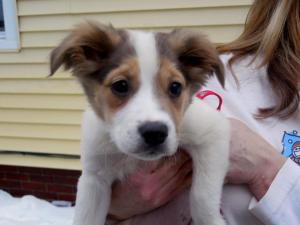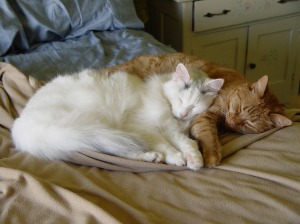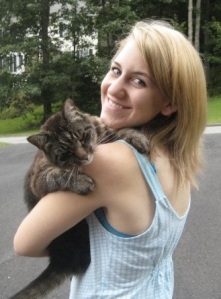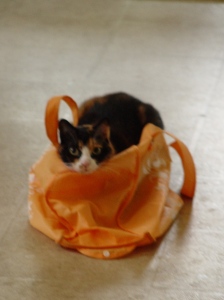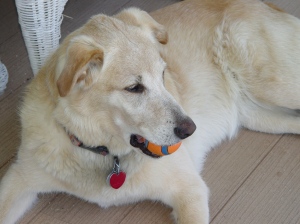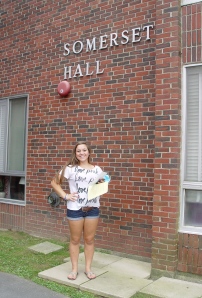“The greatness of a nation and its moral progress can be judged by the way its animals are treated.” — Mahatma Gandhi
I want to go back to just a week ago, when I, blissfully ignorant, did not realize that many animals in shelters across the country are packed in gas chambers and suffocated as a form of “euthanasia.” Being a lifelong animal rights advocate, I can’t believe I didn’t know this until now. I had been researching different animal rescue sites in my search to adopt a puppy to add to our family, and I came across the horrifying revelation. Gas chambers? In 2013? I had thought that, as horrible as it is to euthanize healthy animals simply because there are no homes for them, it was implemented by injection–quick and painless. Yet in my happy search for another dog, I uncovered what many are calling “America’s dirty little secret.” This is a somber and an unpleasant topic, but I do not apologize for it, because it has to be told. Again and again and again, by many voices, until there is change.
According to the “Take Action – Ban Animal Gas Chambers” Facebook page, there are fifteen states in our country whose shelters use gas chambers to kill animals, with eight more states who did not share information about their euthanasia method. Animals are placed in a gas chamber (without sedation) where they suffocate. In some shelters, cats are piled in with dogs, small dogs are mixed in with large dogs, live dogs are placed on top of dead ones, and they all fight each other for the last breath of air. It is often a slow death: sometimes taking twenty minutes or more to kill the animals, who are often packed into the chamber. Some have even had to be put back in for another cycle. It is a barbaric, primitive process.
This knowledge has made it so that lately, my mental energy is focused here, not the novel I’m nearly halfway through. I look at every one of my three dogs and four cats, and I think of animals just like them going in a gas chamber. The puppy I just adopted from a Mississippi rescue was one day away from euthanasia before his litter was pulled from the high-kill shelter…in a state that uses gas. This puppy’s soulful eyes, his baby face, are heart-breaking. I cannot fathom that he could have been one of those killed. I wake up in the night and think of the image I had seen of a dog’s mouth open wide, entitled “One Last Breath.” I think of the photo of the bodies of Shepherd and Lab and hound mixes, the black and brown and yellow dogs of varying sizes, piled up in a metal chamber. I think of their terror and distress, and it is unbearable. But these animals have to bear it – they don’t have a choice.
A couple of nights ago, I posted on my Facebook page a link from the Take Action: Help Ban Animal Gas Chambers site and briefly explained this “dirty little secret.” I said I hoped it would be shared. I apologized for upsetting people and said I didn’t want to bother anyone. And then I got to thinking. People NEED to be upset. We cannot be complacent. Of course we can feel thankful that our pets are safe, loved and well-cared for, but we cannot forget about the millions of other animals who are not so fortunate.
I hope I reach many animal lovers with this post, and that you will want to take action. I am including links below, which I urge you to visit and share. Post, tweet, talk, write. See if your state has a ban on gas chambers, and if it does not, contact government officials. If you are financially able, adopt pets from shelters or rescues. If you can’t adopt, perhaps you can foster. Join a rescue website and share the available animals posted. And in the wise words of Bob Barker, spay and neuter your pets!
My husband teases me about how I want to save them all. And I do. I want to save every terrified cat, every cowering dog. It breaks my heart that I can’t. At the very, very least, I want these animals who tragically must die–through no fault of their own–to have quick, humane deaths at the hands of compassionate individuals. I want to not only raise awareness of this issue, but to bring about change. Ignorance may be bliss…but knowledge is power. We need to save them. And in doing so, we save ourselves.
http://www.facebook.com/TakeAction.BanAnimalGasChambers?fref=ts
http://www.facebook.com/notes/take-action-help-ban-animal-gas-chambers/letter-from-a-gas-chamber-man-/184542131626038
http://www.takeaction-bananimalgaschambers.com/eyewitnessacounts.htm
American Veterinary Medical Association
http://www.avma.org
My daughter Chloe (now 20) used to be locally famous when she was a toddler for what we called her “Chlo-isms” – cute expressions which I used to write down in a notebook. A few of our favorites were when she’d call bowls, cups and plates “food furniture,” telling us emphatically “I don’t like nuns,” and announcing after she’d gotten dressed, “My boots are too tight, but I don’t matter.” Little did I know that today, seventeen years later, I’d be documenting her sayings again…after she had her wisdom teeth removed. I didn’t get a video, but I did have a pen and paper. Here are some of her “words of wisdom” coming out of anesthesia…
Am I in the same room?
[wide-eyed, grabbing my phone] I want everyone to know I’m okay! I’m going to send them a picture of me. [looking at phone and gasping] Your inbox is 100% FULL! [handing it back to me] QUICK!
You have four eyes.
Chlo: They had to wait to start me because there was an emergency.”
Me: What happened?
Chlo [scornfully]:They didn’t tell me. It’s PRIVACY.
Is this the same room?
Don’t laugh at me.
Kiss me on the forehead.
Me: You need to stop talking. The doctor doesn’t want you to talk.
Chlo: [pouting] I like to talk.
Me: You can tell me later.
Chlo: What if I forget?
Me: I’ll remind you.
Chlo: Don’t forget!
Is this a rocking chair?
I like it.
I really like this rocking chair.
[touching her chin, horrified] What is THAT?
I don’t like my tongue right now.
That was FAST. I was asleep, then I was awake!
Me: Do I still have four eyes, Chloe?
Chloe: [singsongy] Hmm…no. You have pretty eyes.
I like the color of this room.
[touching in and around her mouth and announcing it] Gauze. Lip. Gauze. Lip. Teeth.
I’d like to take this blanket home. They should give it as a going away gift. For being a TROOPER.
My tongue should not be in my mouth right now.
Are you writing stuff about me?
Don’t put me in your next book.
I take that back. Write a book about me.
******
Maybe not a book, Chlo, but perhaps a blog post :).
Well, it’s been a month since I’ve written a blog post. That teaching thing I do has put blogging on the back burner – but having 10,000 pets is a big factor, too. Since my menagerie is one of the most prominent things in my life, I thought I’d feature them here. I wrote about my beloved Tucker in my first post, so it’s only fair to introduce the rest of my furry family.
When I say “10,000 pets,” I really mean nine. Two dogs, four cats, two horses and a pony. All with issues. I’ll save the barn animals for a later post and will start with the felines, or as my husband calls them, the Teeming Sea of Cats.
Moby: 5 year old long-haired white cat, one blue eye and one green eye. Also known as Whitey Friendly and the Lurker (always at the door when people enter). Mostly low maintenance except for predisposition to hairballs and needing lube in his food twice a week. Nothing seems to faze him. Provides mild entertainment by pulling open the sliding trash cabinet (nightly) and balancing on the edge of it to see what goodies are inside.
Murphy: 6 year old orange tiger cat. Moby’s same-sex partner. An absolute love; purrs more often than not. Will meow at door for me to take him outside; behaves better than a dog on a leash. Likes to watch TV. Was the first cat to discover the joy of whipped cream. Had a brief, unexplained phobia to seeing whipped cream on the floor after it was sprayed out of the can. That’s all better now.
Dasher: 13 year old gray tiger cat. Probably the most normal pet we own. Loves to hunt and prowl, but a big fan of the lap. Also known as the Third Dog since he likes to walk with us when we take our two dogs down the road.
Moxie: 5 year old calico. Fat. Not her fault. Highly sensitive; at times borderline psycho. Developed a deep-seated fear of dog Riley after a visiting yellow dog came in our house and scared her. That’s all better now. Loves getting in empty grocery bags after we come back from store. Needy…and kneady. Flips out–and I mean FLLIIPPSS OUTTTT–going to vet. Must be sedated. And so must we, after trying to get her in the carrier.
The Canines
Joey: 6 year old Chihuahua/Spaniel/poodle/your-guess-is-as-good-as-mine mix. A rescue from Arkansas where he was a stray. Also known as Hobo Joe, Couch Dog, The Scrounge, and Four Thousand Dollar Dog (ruptured disc). Likes to make nests for himself out of blankets and must sleep under the covers with his claws in my back. For some reason is scared of the water bowl – will cautiously creep up on it and take tentative, fearful licks. Has conquered this enough to drink, which is good since water is kind of important. Likes to go into the shower stall and lick any remaining water (this may or may not be related to water dish phobia). Distracts self from hunger by playing with ball while food is being prepared. Freakishly obsessed with carrots.
And then there’s Riley:
7 year old yellow Lab mix. Also known as Truck Dog, Farm Dog, or simply, Misery. As a puppy, would randomly get on her back, writhing and making strange growling noises, prompting us to think that something was wrong with her. This has since been confirmed. Given the title “The Fun Police” by my husband since she interferes when he plays with our other dog. She is All About The Ball. Very oral; used to carry rocks and tennis balls in her mouth which subsequently wore her teeth down to nubs. Rocks and tennis balls replaced with expensive orange Chuckit balls which she loses, despite them meaning the world to her. Re-lent-less with requests for you to throw Chuckit. Once ball is thrown, will kill herself scrabbling across the floor to get it. Chewing on it for extended periods causes her eyes to glaze over. Fond of dropping it in things, like pails, horse manure, bag of birdseed in the garage, bin of recyclables, the bulldozer of the guy who delivered us gravel. Believes everything is the cats’ fault and will take any excuse to chase them: husband exclaiming about a bad referee call, me closing my laptop and standing up, someone sneezing. Terrified of vacuum cleaner. Lives to “help” me with horses, which involves dropping her ball at my feet/in the wheelbarrow/under a horse, ignoring my repeated, heated commands of “Riley! GIT!” Playing the part of horseback riding cheerleader by racing around the riding ring as my horse and I attempt not to run her over (except when we are trying to).
Bottom line: Drives my husband and me absolutely nuts, and when I think I can’t take it any more, all I need to do is think of how much I will miss that when she’s gone. We love our pets despite their idiosyncrasies. Or maybe it’s because of them. How is your pet unique or quirky? Please share…misery loves company :).
Recently, I gave my first author talk to kind souls who braved a rainy, blustery night to come out and listen to an unknown. I don’t know if they got anything out of it (I certainly hope so), but I did. I felt like a real author. I also felt relieved that it felt good, and surprisingly easy, to talk about my writing…probably a combination of the friendly atmosphere and because it’s my passion. The fact that I’d rehearsed it a kajillion times and brought notes didn’t hurt, either.
One thing people seemed to like was my display of a stack of books I’d loved as a child. Whenever I am asked how I got started as a writer, I say, as a reader. I wanted to read anything about animals, Charlotte’s Web by the brilliant E. B. White being an all-time favorite. I treasured the bi-weekly trips to the public library and soon narrowed my focus to books about horses. My mother would slip in biographies about Helen Keller and Amelia Earhart, but my heart belonged to Ken McLaughlin in My Friend Flicka, Walter Farley’s Black Stallion series, Elisa Bialk’s Tizz the Pony and C. W. Anderson’s Billy and Blaze)…pretty much any book with anything remotely equine on the front cover was devoured and revered. Not surprisingly, the first stories I wrote were about horses. I even went so far as to take the idea (a/k/a basically copy) the plot and characters of My Friend Flicka. I didn’t know the term for it until grad school, but I was employing intertextuality: the idea that whatever we read becomes part of us, can be consciously or subconsciously “borrowed” and even incorporated into our writing.
This story, entitled Outlaw, the Horse That Ran Away (see – I was original with that, at least), was my first “major” piece, written when I was nine. My favorite elementary school teacher, Mrs. Kleine, would have me stay in at recess so she could edit it with me. (Looking back, I am immensely grateful to her, because after teaching for seventeen years, I F U L L Y appreciate how precious time a teacher’s time is without the children.) My father, who was Dean of the College of Education, wanted to feature a young writer and picked me (imagine) to appear on a bulletin board in the education building. One of the art professors drew three beautiful illustrations, and my Outlaw story was “published.” This was the first time I remember feeling like a real writer.
I did branch out with my reading, enjoying Beverly Cleary’s books and delighting in Louise Fitzhugh’s Harriet the Spy. I even went so far as to keep my own little black notebook where I would spy on people, jotting down Harriet-like things such as “That little boy looks sad…I wonder why” or “That woman in the checkout line is fat…I wonder why.” I would usually add, Think about this, just like Harriet did. I certainly had fun with my observations, and they also helped me realize the vital importance of looking and listening as a writer.
Nancy Drew and Trixie Belden became close friends, although I didn’t end up writing any mysteries. I remember enjoying How To Eat Fried Worms by Thomas Rockwell, as well as his very unique, quirky The Portmanteau Book, which prompted me to experiment with humor in my own writing. As I morphed into a teenager, both the books I read and my writing became more angst-y. Forever by Judy Blume dealt with teen sexuality and was the “must-read (but don’t tell)” book of that time. The sex in it was deliciously shocking, and I later incorporated PG-13 romantic scenes in my writing. I would fill up spiral notebooks with stories and surprised myself by killing off a main character. When I reread what I’d written, I cried and was very taken aback that my words could have that effect (even though it was just on me).
Later authors whom I read voraciously were Stephen King (I marveled at how much that man could scare me) and Flannery O’Connor. Their dark tales and dry humor surfaced in my writing pieces in high school and college. I had never known I had “dark” within me and was quite pleased to find that yes, I do.
It would be nearly impossible to list all of the authors I enjoyed during my youth, and I would love to hear from other readers in their mid to late 40’s about their own favorite books. I am so grateful to the wonderful writers I’ve mentioned here. It is with a bit of sadness that I realize they will never know how much they meant to a scrawny, bespectacled, young horse lover on a yellow beanbag chair in her bedroom. I’m hoping to pay it forward by creating enjoyment for readers of my own.
Thanksgiving may be a couple of months away, but I’m getting a head start on the feeling-thankful thing. There are many lessons I’ve learned as a new citizen of the self-publishing community, and one thing I learned very early on is that overwhelmingly, people are so darn nice. An international best-selling author taking the time to respond to an email from an unknown indie asking about self-publishing…a best-selling U.S. author telling me to call her so she could give me some advice and then talking to me for an hour…another established author sending me lengthy emails outlining specific marketing tips…the people who have taken the time to read, rate or review my book. And at the top of the list: the gracious, professional and kind bloggers and reviewers who understand their importance to an unknown author and write honest, detailed reviews.
The prevailing sentiment there is room for everyone has been echoed repeatedly in all aspects of the self-publishing world. There is sharing of, not competing for, readers. It feels like we’re all in this together–miles and sometimes continents away, but connected by love for the written word. As a mom whose chicks have flown the nest, I have needed to “meet” people, make new friends and build new networks, to stimulate my mind and challenge myself…to fill the empty, aching hole when I used to feel whole.
I’ve been feeling a lot more whole lately. I gave my first official talk as an author last night. As I posted on my Facebook page, I had been torn between wanting no one and a whole bunch of people to show up. It turned out to be just the right number. I was touched and honored that people would come out to listen to a new author, especially on a rainy, blustery night. Let me tell you, there was a whole lot of sunshine in that room.
This new venture of mine has felt good. And when you feel good, you want to do good. Like many writers, I’ve fantasized about what I’d do if I made a lot of money from my books, and this included giving to charity. AUTHOR’S NOTE: I am not making a lot of money. Yet. (A girl can dream.) But it occurred to me, why am I waiting? I have my teaching job. I am comfortable. I am making extra money with my book. Why not start giving now?
At the same time I was mulling over what form this giving should take, it occurred to me that while my main character, hypochondriac Christine, provides laughs for readers as she obsesses over her numerous maladies, the diseases she imagines are real for many people. I want it to be known that I am sensitive to this. From this point forward, I am donating a minimum of 25% of my book royalties to a health organization each month, using the National Health Information Center’s calendar as a guideline. All organizations will come from the U.S. Dept. of Health and Human Service’s website.
September is Ovarian Cancer Awareness Month, and 25% of this month’s royalties will go to the National Ovarian Cancer Coalition in Dallas, Texas. Since October highlights breast cancer, I will donate 50% of my book royalties to the Susan D. Komen Race For The Cure, as I have had family members diagnosed with breast cancer. My beloved grandmother, Rose Abelli Dooling, died of the disease, so it is in her memory that I make this donation.
I am very grateful to those of you who have supported me as a new author. I’m looking forward to celebrating Thanksgiving all year long :).
Let me tell you something about my youngest daughter. She is loud. Correction, LOUD. Not vocally so much as doing things like thundering down the stairs, slamming the toilet lid, and her specialty: shutting doors. No matter how many times we’d tell her to please close the door quietly (at one point, I even demonstrated how to gently close the door and turn the knob so it latched with a soft click), Caleigh never seemed to get it. My husband and I soon gave up, looking at each other and shaking our heads when we’d hear the all-too-familiar click-BAM of the bedroom door upstairs.
I attribute it to her big and blooming personality. Ever since she was a little girl, Caleigh Shayne had charm and swag. When she entered high school as a freshman, even the upperclassmen thought she was cool and wanted to hang out with her. She had everyone (teachers included) eating out of the palm of her hand: a friend to all, genuine, savvy, fun and witty. Now off to college, Cal is beginning a new journey. For really the first time in her life, she’s a little fish in a big, big pond. The confidence she had in both the classroom and on the athletic fields will hopefully serve her well, because what was sure and straightforward in the smaller, sheltered world of high school is not so much anymore.
The business of mothering was also sure and straightforward. For the past twenty-two years, my world has been a flurry of school lunch checks, muddy cleats, smelly sneakers, long-distance games, scribbled parent permission slips, report cards, team gatherings, prom dinners, driving-driving-driving where kids wanted to go or needed to be. There was constant teaching of both major and minor life lessons, and a fair share of grousing (okay, nagging) over the dishwasher that never seemed to get emptied and complaining about damp bath towels draped over the closet door, instead of in the hamper where they belonged. Mother stuff.
But while I’m certainly still a mother and will be for the rest of my life, of course, it’s different now. The night Caleigh moved out, I opened the door to her bedroom and was struck by how quiet it was. Quiet, and still, like the expectant hush before a snowfall. It is still unsettling. No heavy scent of perfume (a/k/a skunk piss) lingering in the air, no raucous rap music my husband and I used to complain about, no teenspeak and laughter from skyping. In the wake of her leaving for college is this emptiness and ache, like a part of me is missing. Which of course, it is.
It was comforting on move-in day to see all the other mothers who were experiencing the same emotions. We’d flash rueful smiles that said, I know, isn’t this tough? as we passed each other in the cramped hallway. As parents, we realize it’s the ultimate goal to prepare your children for life and then (often reluctantly) send them off. You mentally rehearse for this event, tell yourself they’ll be home between semesters, count the days till fall break. You know, however, it will never be the same. And this is what stings.
Still, there are bright spots. The week unfolds more slowly, no hurrying to get to away games after work. A bag of chips lasts longer than a day. There is more time to ride the horse, to write the book. As the new proprietor of an empty nest, I’m finding that I, too, am beginning my own journey into uncharted territory. Both Caleigh and I will ask ourselves the same questions: who am I? what’s important to me? what now? But we will go our separate paths: Caleigh taking her “loud” into the dorm, blending with other new voices in the pandemonium that is college life—while I must learn to listen to myself, in the hush of this empty house.
Hope. Despair. Celebrate. Lament. Repeat.
Why didn’t anyone tell me the world of indie publishing would be so…stressful? overwhelming? agonizing? Ohh wait a minute, they did. But I thought they were talking about other authors’ experiences, which wouldn’t apply to me. Now, as I sit here trying to coax my tweet-fried, over-clicked brain into writing this post while my husband plays on his iPad and sings to the cat, I am in full and utter appreciation of all indies who have come before me: people who have (other) full-time jobs, and children, and pets, and…and…and…but who still make the time to market, promote, research, email, read, blog, tweet, update Goodreads, search for groups and book clubs and reviewers, network with authors, reply to threads–and if they’re lucky, maybe even shower. And write. This is not for the faint of heart. Even as a newbie, I took offense to the recent comments by established, traditional authors who labeled indies as “lazy.” That’s like saying hummingbirds need to step it up.
In fact, that’s a damned good analogy. Sometimes, I feel exactly like a hummingbird: zipping over to dip my beak in the feeder for a taste of delish sugar water, then flitting to the telephone wire to chill for a sec before beelining it to a very attractive petunia and zooming to nest in a pine tree. Except the sugar water is a delish review, the telephone wire is where I balance precariously between self-labels of success and failure, the petunia is bestseller status, and the pine tree is the shelter and safety of my pre-indie life.
I knew self-pubbing would take time, I knew it would take determination, I knew it would take effort. I didn’t know you would need to add “tremendous” in front of each of those characteristics, and I didn’t know it would take so much courage. It’s scary as hell to put your book out there – to leave it all alone like a frightened toddler in a dark and tangled jungle of a million other unfamiliar creatures (some of which bite). Kimberly Llewellyn, my first professional reviewer to whom I will always be immensely grateful, thanked me for trusting her with my “baby.” She got it. From what I have seen, indie reviewers are kind, professional and know what’s at stake. Still, mailing out a paperback or pressing the button to send your ebook prompts a deep, here-we-go, I-hope-they-like-it sigh. It takes courage to believe in yourself when a flurry of sales slows down, and when you realize how staggering the odds are against you to get noticed, let alone make it big.
In the midst of all this indie-induced stress, it certainly helps to keep a sense of humor. The night after my book went live, my husband and I had dinner at one of our favorite local restaurants, wanting to celebrate the beginning of my new journey as an author. Our waiter, a/k/a The Weakest Link, was a very nice young man, but forgot the lemon for my water (twice), didn’t give us chips and salsa, and brought us the wrong meals. I told my husband I wanted to grab the waiter by the shirt and say, “DO YOU KNOW WHO I AM? I’ve sold EIGHT COPIES on Amazon!” I’m sure he would have been impressed.
I know I am far from alone in what I’ve experienced with indie publishing. And I know this is just the first step on a long, long road. I will draw upon the strength, tenacity and courage of other indies as we all strive to realize The Dream. I’ll call forth the kind words and advice of authors and reviewers who were truthfully too busy to offer support to a newbie, but who did it anyway. Here’s to all the inhabitants of our brain-straining, heart-hammering, soul-stirring indie world. Fellow hummingbirds, take flight!
So in my other life, I’m a teacher: grades five through eight, at an absolutely wonderful school, with absolutely wonderful students. Very soon, all of us will be reunited. The summer is slip-sliding away, as it does every year. And I’m thinking I speak for all teachers, all across the country, when I say, Make. It. Stop.
It’s hard to believe I’ve been at it for seventeen years. When I used to hear veteran teachers talk about how they’d been teaching for twenty years or more, I’d smile and arrange my face to look very impressed. But secretly, I’d be thinking, my God, you poor bastard! I couldn’t do the same thing for that long! Yet here I am. Looking back on the years I’ve spent in education, there are certain moments that beg to be told. I’m not talking about the feel-good, I’ve-made-a-difference, this-child-started-out-as-a-failure-and-now-he’s-President-of-the-United-States moments (I’ve had those, of course). I’m talking about the moments you sure as hell wouldn’t relive, but never want to forget. And each of these gems has an individual lesson to be learned. Step into my classroom, sit down at a desk, and I will teach you my lesson for the day. You may want to take notes.
In the very early years of my educational career, when I was young and foolish (as opposed to middle-aged and foolish), I taught kindergarten. I’d only had a few years of experience, and that was teaching fourth graders, so going from the intermediate level to brand new babies made me quite nervous. And by “quite nervous” I mean utterly terrified. A big event in kindergarten was 100’s Day, where you’d celebrate the 100th day of school. Sounds innocent enough. But during this particular year, 100’s Day fell on Valentine’s Day–another major event in kindergarten. So I did what any naive, inexperienced teacher would do. I crammed both events into one morning. I was quite proud of myself for having lots of activities for the children to do. And by “lots” I mean way too many.
We started off the morning by making 100’s crowns and using 100 little stickers to decorate them. We counted to 100 by ones, fives and tens and learned “Happy 100’s Day” in sign language. We did 100’s Day centers, including making a design with 100 pattern blocks and making pages for a big “I wish I had 100 ___” book. We ate 100’s Day snacks (I’d had parents send in 100 edible items such as Cheerios, M & M’s, Skittles, and raisins) and made Froot Loop necklaces using–you guessed it–100 Froot Loops. We also decorated a 100-inch snake and played a Find The Dot game which involved hunting for colored stickers around the room, numbered–you guessed it–1 to 100.
This would have been all well and good, had the children been allowed to take oh, maybe, the rest of the year to do this. But we did it in about an hour and a half. I kept an eye on the clock, because we still had Valentine’s Day to celebrate, after all. I bounced around from table to table, cheering on the children, wanting them to experience the full scope of all the amazing things I had to offer. “Great job!” I burbled. “You’re doing really well! Let’s hurry up, though, so we can go on to something else!” I threw lollipops on the tables and told the kids to lick them 100 times. After about ten minutes of frantic licking, one little boy said his tongue was getting sore. I was undaunted. “You’re doing great!” I told him. “Just keep it up! Only about seventy-five more licks!”
When I was satisfied that the children had fulfilled my expectations for 100’s Day, we quickly switched over to Valentine’s, which involved decorating paper bags to collect cards. I was quite pleased with myself for having the children put their finished bags on a long table, because I was going to have them form an orderly line and drop their Valentines into the other children’s bags. This would have gone so, so much more smoothly, had I remembered to check that the children had put their actual names on the bags. Instead of the orderly line I’d dreamed of, there were five year olds crowded around the table, bumping and shoving each other, putting in Valentines, taking them out, looking in their own bags to see how many cards they’d gotten, and looking into everyone else’s bags as well. During this melee, I’d neglected to watch the clock, and when I finally glanced up, I realized to my horror that the bus was coming in fifteen minutes. Kindergartners, on a good day, need about an hour to pack up. And we hadn’t even eaten the Valentine’s Day party food.
I told the children to hurry up and finish putting their Valentines into bags. More bumping and shoving, with cards fluttering down to the floor. I bent down and grabbed the stray Valentines, shoving them into the bags nearest to me. I told the children to quickly find a seat, and I began filling plates with cupcakes and candy and fruit that had been sent in by parents and pouring (spilling) drinks, all the while telling the kids to hurry and eat, the bus would be coming. It was a valiant effort. The little troopers slurped their drinks and wolfed down the goodies, which had to squeeze in beside the 100’s Day snacks they’d just eaten.
The clock was ticking. Panicked, I told the children to throw their plates in the trash and get their backpacks. Half-eaten brownies and cupcakes sailed through the air. The children tripped over each other in their haste to get to the bus. I grabbed the overstuffed Valentine’s bags and tossed them at the kids as they headed for the door, praying that at least a couple of these bags would find their rightful owners. Never had I been so glad I didn’t have a room mother present for this fiasco…but never had I needed one more.
So…what is to be learned from this experience, apt pupil? Yes, that’s right: sometimes, less is more. And more importantly: Slow down. Savor. Enjoy. Lazily lick a lollipop. Taste the chocolate frosting on a cupcake. Delight in making swirly designs on a homemade card for a special someone. Fill your eyes with the sunrise on a lazy August morning that promises to be yours alone. Watch the sky turn to flame at dusk as the sun slips below the horizon. Hang on to sultry summer…to tender moments…to who you are, right now–because all are fleeting. I have taught, but I have also learned.
So here it is, staring me in the face. My first blog. It’s not like I haven’t been thinking about it, because I have…it just hadn’t taken on a shape yet. It reminded me of this interactive sand-art I used to play with as a kid: an oval frame filled with sky blue and white sand. Depending on your mood, you could shake it hard or tip it slowly from side to side, watching the sand swirl and make different shapes. When you found a shape you liked, you’d stop shaking and just sit with it awhile–until you wanted to make the sand change and move on to something else. That’s essentially what I’ve done to create this blog, what I’ve done all my life to begin a piece of writing. Some of my ideas have been rather vigorous in nature, the product of hard thinking and things I must say, while others have been more delicately and carefully arranged.
And now for the shape of this particular piece of “art.” Seeing as it’s my first blog, I wanted it to be memorable and reflective of me. I felt pressure to be funny, because my novel, I KILL ME, is mainly humorous. But just like in my book, there are other layers to me. I wanted to write about something real and moving, something me, but hopefully something others could connect with. And I could not think of anything more real and moving and “connecting” than to write about my dog, Tucker.
If there are two things I know about this world, it’s that championship soccer games shouldn’t be decided by penalty kicks, and dogs don’t live long enough. Even when they get to be fifteen.
It was May of 1998. On the way home from running errands, I passed the Humane Society. I would always feel a twinge driving by, picturing the wide-eyed, fearful stare of a senior cat, the timid dog thumping his tail in the corner of his cage. But this time, I felt more than a twinge – I felt a pull. I knew it was foolhardy–nay, colossally STUPID, to go in there. We already had a lively eight year old black Lab mix and three cats. But for whatever reason, I found myself driving into the parking lot and moments later, standing in front of the cage of what was to become my second dog. He was twelve weeks old, a black Lab/shepherd mix with a white streak down his chest and ears that didn’t know what they wanted to do yet. He came to the front of the cage when he saw me, wagged his tail, and then went back to his bed and curled up to nap, tucking his tail beneath him, and acting as though everything was right with the world. I decided I had to have him.
At the beginning, everything about it screamed mistake! Completing the adoption paperwork caused me to get home about five minutes later than I should have, so that my first grade daughter got off the bus to a locked door, and I found her crying on the steps – until she saw the puppy. No one seemed to understand why I had felt the need to get a second dog. I didn’t understand why I felt the need to get a second dog. Even though I was his new mom, I had not fallen instantly in love with him as I had with our other dog. This new puppy had a dull coat and a bloated, worm belly, and he was quiet and didn’t lick and jump on us as puppies usually did. I remember all five of us, my husband, three daughters and me, sitting in the bathroom as I prepared to give him a quick bath in the tub, while he just lay on my husband’s lap. Sometimes quiet puppies can turn out to be aggressive dogs, I thought. What if he turns out to be mean? What if having two dogs is too much to handle? Our older dog had seemed less than enamored with the new addition. For a few fleeting moments, I considered bringing the puppy back. I thought of it all that first day, right up until the time I took him out to pee that afternoon, and instead of me having to lead him to the door, he bounded up the steps and sat, waiting to be let in, and I thought with a pang, even as little as he was, he knew this was his house. His. And I stopped thinking about bringing him back. I shudder to think of what we would have missed if I’d brought him back.
I say, without reservation and unapologetically to the millions of dog owners out there, that Tucker was the Best Dog In The World. His mellow, dignified nature carried through his puppyhood to old age. Our house was always teeming with neighborhood kids, lively with birthday parties and barbecues, and none of this would faze Tucker. Later on in his life, when we added kittens to our family, he didn’t even lift his head off the rug to sniff them. The dog was the meaning of the word chill.
There were only two things that would get him riled: the first was when our neighbors would walk their Standard Poodle up the road, and then Tucker would become uncharacteristically unglued (perhaps because the dog looked decidedly un-canine). The second thing was the water. When we’d drive near a large body of water, the Lab in Tucker would completely overtake anything else he was made of. He’d tremble and drool until the windows were steamed up and the upholstery was spattered with droplets of his saliva, and the car would be filled with the sounds of kids protesting and Tucker’s loud, throaty panting. During what would be his last trip to the ocean at my parents’ seaside home, Tucker, at fourteen, his legs stick-straight with arthritis, leapt out of the car upon arrival and raced to the water. Oblivious to our pleas to slow down, Tucker scrambled down the embankment and landed upside down in the bushes, until my father rescued him.
One of the things I appreciated most about Tucker was that he was always There. There when my kids were growing up, in so many family photos: one of him playing in a pile of loam we’d had delivered, his snout covered in dirt, while my three little girls in their bathing suits looked on, giggling. There as my faithful and ever-ready jogging partner, his leash looped loosely around my waist, bringing I love dogs, too smiles from passers-by. There during my unexpected, difficult divorce, when everything I had believed in was no more. But I could always believe in Tucker. And he was There to approve the new man in my life, my husband-to-be who grew to love Tucker as much as I did—a man I loved partly for his willingness to take twice as long installing my new front door because he was throwing the tennis ball for Tucker. Priorities.
Tucker had been around so long that we liked to say he’d done it all. Tucker used to be a general in the Korean War. Tucker knew about the challenges of coaching the Celtics. When Tucker was CEO of General Electric… you get the idea. He was also bright enough to understand past tense, looking at us with interest when we’d say things like, “‘Member when we went for a ride? And got a donut? ‘Member that?” He responded to many nicknames: Charlie Brown. Chuck Brown. Biggity Big. Hot Diggity Dog. Blackety-Black, don’t talk back. When he would hobble slowly in his later years: Rocket. And my personal favorite: Mr. Moonlight.
He used to talk with his ears. Much of the time, they were in flying nun-mode, but when he was standing outside at the door waiting to come in and saw your face in the window, his ears would go down flat which meant “oh good, you’re there.” His ears were damned cute, but they didn’t always work. At times, he had selective hearing. He couldn’t hear you calling to him when he wanted to stay outside or caught a scent of something interesting, but he sure could hear the crinkle of a wrapper, or the crunch of teeth into an English muffin.
One of the most wonderful things about him–the fact that he was always There–was also the hardest thing to accept when he died. I used to try and prepare myself for the day when he would no longer be with us. I knew it was coming, knew it when our family room turned into a Geriatric Canine Center, complete with a small tarp underneath his bed, knew it when I petted him during the last few weeks and felt the stark reality of rib-rib-rib. No matter how much you wished it wasn’t so, no matter how much you wanted him back, you had to move toward acceptance and learn to deal with the split-second burst of heart-leaping hope, followed by crushing sadness, when you came into the family room and thought you saw him on the rug. For a dog that didn’t say boo, the house became eerily silent without him. While I fully realize that people endure far, far worse than saying goodbye to an old dog, still, the ache is tremendous. You don’t realize there is sentimentality in a tuft of black hair in the house (or even poop in the yard), until you’ve lost a dog.
I had been trying to find just THE right phrase to capture the essence of this dog, until my husband said, simply, “he was a perfect gentleman to the end.” And he was, although I do not want to think of him as having ended. I will instead imagine him racing headlong into the waves on the legs of his youth, his fierce love for the ocean throbbing in his blood, my Tucker Everlasting.
